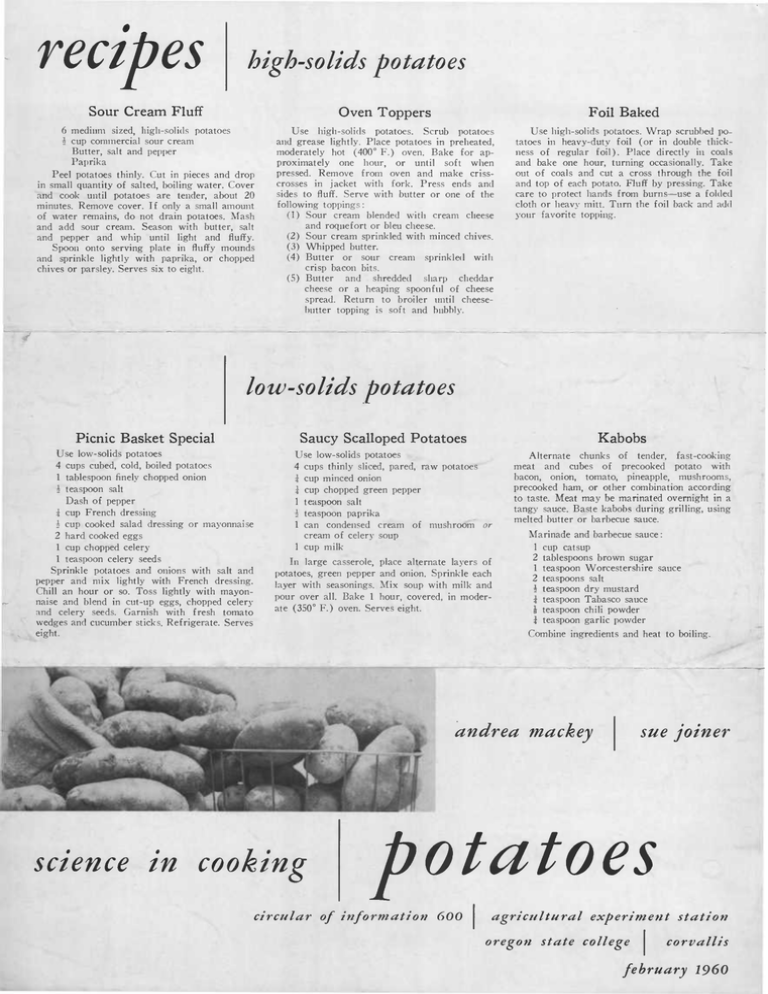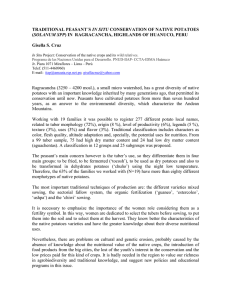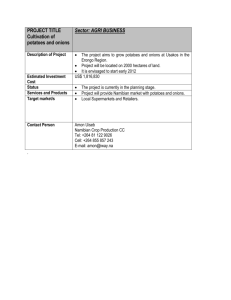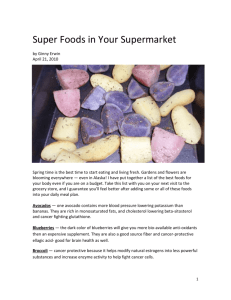recipes high-solids potatoes
advertisement

recipes high-solids potatoes Sour Cream Fluff Oven Toppers Foil Baked 6 medium sized, high-solids potatoes i cup commercial sour cream Butter, salt and pepper Paprika Peel potatoes thinly. Cut in pieces and drop in small quantity of salted, boiling water. Cover and cook until potatoes are tender, about 20 minutes. Remove cover. If only a small amount of water remains, do not drain potatoes. Mash and add sour cream. Season with butter, salt and pepper and whip until light and fluffy. Spoon onto serving plate in fluffy mounds and sprinkle lightly with paprika, or chopped chives or parsley. Serves six to eight. Use high-solids potatoes. Scrub potatoes and grease lightly. Place potatoes in preheated, moderately hot (400° F.) oven. Bake for approximately one hour, or until soft when pressed. Remove from oven and make crisscrosses in jacket with fork. Press ends and sides to fluff. Serve with butter or one of the following toppings: (1) Sour cream blended with cream cheese and roquefort or bleu cheese. (2) Sour cream sprinkled with minced chives. (3) Whipped butter. (4) Butter or sour cream sprinkled with crisp bacon bits. (5) Butter and shredded sharp cheddar cheese or a heaping spoonful of cheese spread. Return to broiler until cheesebutter topping is soft and bubbly. Use high-solids potatoes. Wrap scrubbed potatoes in heavy-duty foil (or in double thickness of regular foil). Place directly in coals and bake one hour, turning occasionally. Take out of coals and cut a cross through the foil and top of each potato. Fluff by pressing. Take care to protect hands from burns—use a folded cloth or heavy mitt. Turn the foil back and add your favorite topping. low-solids potatoes Picnic Basket Special Use low-solids potatoes 4 cups cubed, cold, boiled potatoes 1 tablespoon finely chopped onion i teaspoon salt Dash of pepper i cup French dressing i cup cooked salad dressing or mayonnaise 2 hard cooked eggs 1 cup chopped celery 1 teaspoon celery seeds Sprinkle potatoes and onions with salt and pepper and mix lightly with French dressing. Chill an hour or so. Toss lightly with mayonnaise and blend in cut-up eggs, chopped celery and celery seeds. Garnish with fresh tomato wedges and cucumber sticks. Refrigerate. Serves eight. Kabobs Saucy Scalloped Potatoes Use low-solids potatoes 4 cups thinly sliced, pared, raw potatoes i cup minced onion 4 cup chopped green pepper 1 teaspoon salt i teaspoon paprika 1 can condensed cream of mushroom or cream of celery soup 1 cup milk In large casserole, place alternate layers of potatoes, green pepper and onion. Sprinkle each layer with seasonings. Mix soup with milk and pour over all. Bake 1 hour, covered, in moderate (350° F.) oven. Serves eight. Alternate chunks of tender, fast-cooking meat and cubes of precooked potato with bacon, onion, tomato, pineapple, mushrooms, precooked ham, or other combination according to taste. Meat may be marinated overnight in a tangy sauce. Baste kabobs during grilling, using melted butter or barbecue sauce. Marinade and barbecue sauce : 1 cup catsup 2 tablespoons brown sugar 1 teaspoon Worcestershire sauce 2 teaspoons salt i teaspoon dry mustard i teaspoon Tabasco sauce i teaspoon chili powder i teaspoon garlic powder Combine ingredients and heat to boiling. sue jotner andrea mackey science in cookiing potatoes circular of information 600 agricultural experiment station Oregon state college corvallis february I960 science in cooki ng potatoes Potatoes of the future may come to market labeled to show how they should be cooked—baked, boiled, or fried. While certain varieties of potatoes look much alike from the outside, research shows they differ in interior texture. Some are mealy, others waxy. | Mealy potatoes are delicious when baked, mashed, or french fried. They are light, fluffy, and separate easily into smooth, glistening particles when broken with a fork. But if mealy potatoes are boiled they may slough off, break up, and be soft on the outside while still hard at the center. Waxy potatoes are best when boiled. They retain their shape and are excellent served whole, sliced for salads, or cooked in casseroles. Scientists have developed a simple way to determine whether potatoes are mealy or waxy. Dissolve 1 cup table salt in 11 cups water and immerse the potato. If it floats it has "low solids content" and is best for boiling or use in casseroles and salads. If it sinks it has "high solids content" and will be best baked or mashed. This test works because all potatoes, containing as they do, starch, protein, cellulose, pectin, and other "solids" will sink in plain water. But in a salt solution potatoes with a low starch and solids content will float—while those with a high starch content will sink. This same solids content determines texture of the potatoes when they are cooked. Low solids floaters have a waxy texture, and high solids sinkers have a mealy, light, fluffy texture. The Russet Burbank—also known as Netted Gem—is the variety found most frequently in Oregon markets. These potatoes are successfully stored for many months and may be purchased not only in October, during harvest, but as late as June. Russet Burbanks have a well-earned reputation for high pOtatO pointers quality. They usually tend to have a high solids content, and are deliciously mealy and fluffy when baked or mashed. Waxy, low solids potatoes are also found in this popular variety. Russet Burbanks from farms in Central and Southern Oregon were tested for two years to determine relative solids content. About one-third of those tested proved to be low solids potatoes. This proportion will differ from year to year, as each crop will have certain individual characteristics. Homemakers often prefer to boil potatoes, but frequently find that some break up during cooking. This is because of the high solids content of so many potatoes in the crop. In harvest season, cells of Russet Burbank potatoes are thick and starchy, so bits of tissue are more apt to slough off when the potatoes are boiled. During storage, part of the starch is gradually used by the potato—in plant metabolism—so cells tend to stick together. Today potatoes sold commercially aren't divided according to solids content. But when practical methods of using the salt solution test are developed, packers will be able to classify each potato for its best use. for homemakers • Potatoes—whether low or high solids—are high in food value. They contain Vitamin C, certain of the B vitamins—thiamine and niacin—and the minerals, iron, phosphorous, and potassium. • One pound of potatoes, cut up and diced, will yield three to four average servings. So potatoes are a source of nutritious, inexpensive food. • Potatoes are not fattening. One medium Russet Burbank contains about 100 calories—the same as a large apple or orange. • Potatoes are perishable and should be handled gently. They keep best in a dark, cool place. • Potatoes retain most food value if cooked in their jackets. As little writer as possible should be used when potatoes are boiled. Many of the food nutrients found in potatoes are just under the skin, so peelings should be thin. Cookbooks of the future may give the homemaker additional help by specifying high or low solids potatoes in recipes. Till then, OSC home economists have developed recipes designed especially for low and high solids potatoes.



